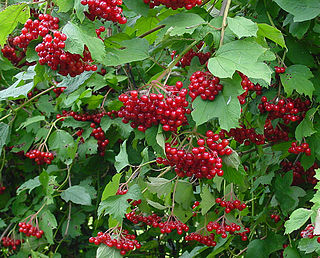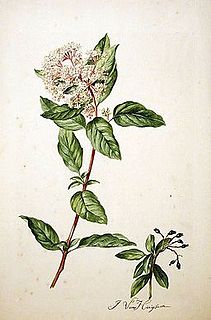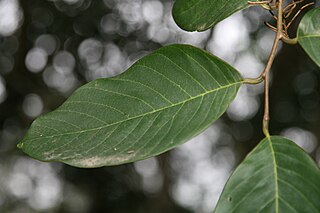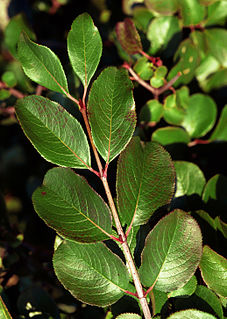
Viburnum is a genus of about 150–175 species of flowering plants in the moschatel family Adoxaceae. Its current classification is based on molecular phylogeny. It was previously included in the honeysuckle family Caprifoliaceae.

Viburnum opulus, the guelder-rose or guelder rose ) is a species of flowering plant in the family Adoxaceae native to Europe, northern Africa and central Asia.

Viburnum tinus, the laurustinus, laurustine or laurestine, is a species of flowering plant in the family Adoxaceae, native to the Mediterranean area of Europe and North Africa. Laurus signifies the leaves' similarities to bay laurel.

Viburnum prunifolium is a species of Viburnum native to eastern North America, from Connecticut west to eastern Kansas, and south to Alabama and Texas.
Cassine viburnifolia is a mangrove plant of tropical Asia in the staff vine family Celastraceae. The specific epithet viburnifolia refers to how the plant's leaves resemble those of the genus Viburnum.
Molinadendron hondurense is a species of plant in the family Hamamelidaceae. It is endemic to Honduras.
Viburnum arboreum is a species of plant in the Adoxaceae family. It is endemic to Jamaica.

Viburnum costaricanum is a species of plant in the Adoxaceae family. It is found in Costa Rica and Panama. It is threatened by habitat loss.
Viburnum divaricatum is a species of plant in the Adoxaceae family. It is endemic to Ecuador. Its natural habitat is subtropical or tropical moist montane forests. It is threatened by habitat loss.
Viburnum elatum is a species of woody plant in the family Adoxaceae. It is endemic to eastern Mexico.

Viburnum maculatum is a species of plant in the family Adoxaceae. It is found in Montenegro on Lovćen and Orjen mountains, as well as in parts of Bosnia and Herzegovina. This plant is a xerophyte, and grows on karst mountain terrains.
Viburnum molinae is a species of plant in the Adoxaceae family. It is endemic to Honduras.
Viburnum mortonianum is a species of plant in the Adoxaceae family. It is found in El Salvador and Guatemala.

Viburnum stellato-tomentosum is a species of plant in the Adoxaceae family. It is found in Costa Rica and Panama. It is threatened by habitat loss.
Viburnum subpubescens is a species of plant in the Adoxaceae family. It is endemic to Honduras.
Viburnum tridentatum is a species of plant in the Adoxaceae family. It is endemic to Peru.

Viburnum nudum is a deciduous shrub in the genus Viburnum within the muskroot family, Adoxaceae.

Viburnum rufidulum, also known as the rusty blackhaw, blue haw, rusty nanny-berry, or southern black haw, is a flowering species of shrub or small tree that is common in parts of the Eastern and Central United States. It produces attractive flowers and fall foliage, as well as fruits that are popular with some species of bird.

Viburnum treleasei is a species of Viburnum endemic to the Azores. It inhabits natural forests of Juniperus brevifolia, Laurus azorica and Ilex perado, Erica azorica, in sloping areas. Generally at altitudes above 200 m (660 ft). It is present in eight of the nine islands.

Viburnum recognitum, variously called the northern arrowwood, southern arrowwood, and smooth arrow-wood, is a species of flowering plant in the family Viburnaceae. It is native to eastern Canada, and the central and eastern United States. A shrub or small shrubby tree, they are typically found in wetter habitats such as stream banks, bottomlands, swamps, and mesic woodlands. It is closely related to, and may be a subtaxon of, Viburnum dentatum, the southern arrowwood or roughish arrowwood.











